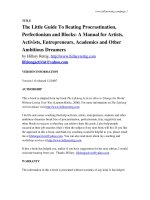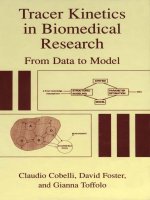MANUALS IN BIOMEDICAL RESEARCH VOL 3 - A MANUAL FOR BIOCHEMISTRY PROTOCOLS pot
Bạn đang xem bản rút gọn của tài liệu. Xem và tải ngay bản đầy đủ của tài liệu tại đây (1.49 MB, 142 trang )
February 19, 2007 18:12/SPI-B464 (Ed: Kim Wei) A Manual for Biochemistry Protocols Trim Size for 5in x 8.5in fm
FA
This page intentionally left blankThis page intentionally left blankBritish Library Cataloguing-in-Publication Data
A catalogue record for this book is available from the British Library.
For photocopying of material in this volume, please pay a copying fee through
the Copyright Clearance Center, Inc., 222 Rosewood Drive, Danvers, MA
01923, USA. In this case permission to photocopy is not required from the
publisher.
ISBN-13 978-981-270-066-7 (pbk)
ISBN-10 981-270-066-8 (pbk)
Typeset by Stallion Press
Email:
All rights reserved. This book, or parts thereof, may not be reproduced in any
form or by any means, electronic or mechanical, including photocopying,
recording or any information storage and retrieval system now known or to be
invented, without written permission from the Publisher.
Copyright © 2007 by World Scientific Publishing Co. Pte. Ltd.
Published by
World Scientific Publishing Co. Pte. Ltd.
5 Toh Tuck Link, Singapore 596224
USA office: 27 Warren Street, Suite 401-402, Hackensack, NJ 07601
UK office: 57 Shelton Street, Covent Garden, London WC2H 9HE
Printed in Singapore.
Manuals in Biomedical Research — Vol. 3
A MANUAL FOR BIOCHEMISTRY PROTOCOLS
Wanda - A Manual for Biochemistry.pmd 4/17/2007, 4:49 PM1
February 19, 2007 18:12/SPI-B464 (Ed: Kim Wei) A Manual for Biochemistry Protocols Trim Size for 5in x 8.5in fm
FA
Preface
The field of biochemistry is diverse and forms parts of diverse
fields including cell biology, molecular biology and medical sci-
ences. Biochemistry is the study of the molecules of life like
proteins, lipids, carbohydrates and nucleic acids. Studying the
structure, properties and reactions of these important molecules
would help in better understanding life as a whole. The prac-
tical aspect along with the theoretical background would help
in better understanding these mechanisms. This book tries to
address and compile some of the routinely used protocols in bio-
chemistry for easy access. The aim of this book is not only to
bring together the protocols, but also to understand some of
the basics behind following the methodologies. The target is
to give students a view of biochemistry, especially those who
have just ventured into the field of biochemistry and need a
headstart.
The protocols are written as a handy guide that can
be carried as a pocket guide for easy reference. The pro-
tocols are easy to follow with each step explained in lay-
man terms. Even though the field of biochemistry is exhaus-
tive, an effort has been made to list some of the protocols
that could serve as a foundation for starting any biochemical
investigation.
v
February 19, 2007 18:12/SPI-B464 (Ed: Kim Wei) A Manual for Biochemistry Protocols Trim Size for 5in x 8.5in fm
FA
vi
Preface
We would like to thank all the members of the lab, especially
Dr Sravan Kumar Goparaju and Xue Li Guan, whose help in
reviewing the manuscript is greatly appreciated. We would also
like to thank all the people previously involved in designing these
protocols.
Markus R. Wenk
Aaron Z. Fernandis
February 19, 2007 18:12/SPI-B464 (Ed: Kim Wei) A Manual for Biochemistry Protocols Trim Size for 5in x 8.5in fm
FA
Contents
Preface
Preface
Preface v
List of Figures
List of Figures
List of Figures xi
List of Contributors
List of Contributors
List of Contributors xiii
A Protein Purification
A Protein Purification
A Protein Purification 1
A.1 Protein Precipitation 2
A.2 Column Chromatography 3
A.2.1 Ionic Exchange Chromatography 3
A.2.2 Size-Exclusion Chromatography 6
A.2.3 Affinity Chromatography 6
A.2.4 Purification of Recombinant Proteins 7
A.2.5 Commercially Prepacked Column Kits 9
Notes 12
B Protein Analysis
B Protein Analysis
B Protein Analysis 15
B.1 Protein Estimation 16
B.1.1 Absorbance Assays 16
B.1.2 Colourimetric Assays 17
B.1.3 Commercial Protein Estimation Kits 18
B.2 Spectrometric Analysis 19
B.3 SDS-PAGE 21
B.4 Gel Staining 26
B.4.1 Coomassie Blue Staining 26
B.4.2 Silver Staining 27
B.5 Western Blotting 28
vii
February 19, 2007 18:12/SPI-B464 (Ed: Kim Wei) A Manual for Biochemistry Protocols Trim Size for 5in x 8.5in fm
FA
viii
Contents
B.6 Immunoprecipitations 32
Notes 35
C Lipid Analysis
C Lipid Analysis
C Lipid Analysis 39
C.1 Lipid Extraction 40
C.1.1 Modified Bligh and Dyers Method for
Phospholipid Extraction 40
C.1.2 Folch Extraction 41
C.1.3 Grey Method for Phosphatidylinositol
Phosphate Extraction 42
C.1.4 Modified Alex Brown Method for
Phosphatidylinositol Phosphate
Extraction 44
C.1.5 Hexane Extraction for Neutral Lipids 44
C.1.6 Glycolipid Extraction 45
C.2 Thin Layer Chromatography 46
Notes 49
D Mammalian Cell Culture
D Mammalian Cell Culture
D Mammalian Cell Culture 53
D.1 Primary Culture 54
D.1.1 Primary Cell Isolation and Culturing 54
D.1.2 Splenocyte Isolation 55
D.1.3 Isolation of Peripheral Blood
Lymphocytes 57
D.2 Tissue Culture 58
D.2.1 Adherent Cells 58
D.2.2 Suspension Cells 60
D.2.3 Cell Maintenance 61
D.3 Cell Count 62
D.4 Mammalian Transfection 64
D.4.1 Calcium Phosphate Coprecipitation 64
D.4.2 Electroporation Protocol 65
D.4.3 Lipofectamine Transfection Protocol 66
Notes 68
E Microscopy
E Microscopy
E Microscopy 71
E.1 Poly-L-Lysine Immobilisation 73
E.2 Immunofluorescence and Confocal
Microscopy 74
E.3 Immunohistochemistry 75
Notes 77
February 19, 2007 18:12/SPI-B464 (Ed: Kim Wei) A Manual for Biochemistry Protocols Trim Size for 5in x 8.5in fm
FA
Contents
ix
F Assays
F Assays
F Assays 81
F.1 Enzyme Assays 82
F.1.1 Enzyme Kinetics: Basics 82
F.1.2 Lipid Kinase Assay 84
F.1.3 Protein Kinase Assay 86
F.1.4 Protein Tyrosine Phosphatase Assay 88
F.1.5 Alkaline Phosphatase Assay 90
F.1.6 Caspase Assay 90
F.2 Functional Assays 92
F.2.1 Apoptosis Assay 92
F.2.2 XTT Cell Proliferation Assay [(2,3-Bis
(2-methoxy-4-nitro-5-sulfophenyl)-
2H-tetrazolium-5-carboxanilide)] 94
F.2.3 Chemotaxis Assay 95
F.2.4 Matrigel Invasion or Chemoinvasion
Assay 97
Notes 100
G Autoradiography
G Autoradiography
G Autoradiography 103
Notes 105
Suggested Readings
Suggested Readings
Suggested Readings 109
Abbreviations
Abbreviations
Abbreviations 113
Appendices
Appendices
Appendices 115
Appendix 1 Safety Issues 116
Appendix 2 Buffer Chart 118
Appendix 3 Composition of Regular Buffers
or Stock Solutions 120
Index
Index
Index 125
February 19, 2007 18:12/SPI-B464 (Ed: Kim Wei) A Manual for Biochemistry Protocols Trim Size for 5in x 8.5in fm
FA
This page intentionally left blankThis page intentionally left blank
February 19, 2007 18:12/SPI-B464 (Ed: Kim Wei) A Manual for Biochemistry Protocols Trim Size for 5in x 8.5in fm
FA
List of Figures
Figure Description Page
A.1 Protein precipitation using ammonium
sulfate 5
A.2 Ion exchange chromatography 5
A.3 Gel filtration chromatography 6
A.4 Affinity chromatography 7
A.5 Flow chart for column chromatography 8
B.1 Standard graph for protein estimation using
known concentration of BSA as standard 20
B.2 Flow chart of spectrophotometer 20
B.3 SDS-PAGE. (A) Different parts of the
electrophoretic apparatus. (B) Running the
SDS-PAGE 23
B.4 Reaction occurring on the membrane 29
B.5 Cartoon depiction of the Western blot
sandwich 30
C.1 Phase separation during lipid extraction 41
C.2 Thin layer chromatography 47
xi
February 19, 2007 18:12/SPI-B464 (Ed: Kim Wei) A Manual for Biochemistry Protocols Trim Size for 5in x 8.5in fm
FA
xii
List of Figures
C.3 Thin layer chromatography chamber and
TLC plate 47
D.1 Ficoll gradient for enrichment of peripheral
blood lymphocytes 57
D.2 Tissue culture hood 59
D.3 CO
2
incubator 59
D.4 Cartoon depiction of a hemocytometer 63
E.1 A typical light microscope 72
E.2 Principle of fluorescence emission 73
F.1 Lineweaver–Burke plot and determination of
K
m
and V
max
83
F.2 Cartoon depiction of the transwell plate used
for chemotaxis assay 96
F.3 Cartoon depiction of the transwell plate used
for Matrigel-based chemoinvasion assay 98
February 19, 2007 18:12/SPI-B464 (Ed: Kim Wei) A Manual for Biochemistry Protocols Trim Size for 5in x 8.5in fm
FA
List of Contributors
Xue Li Guan, BSc
Yong Loo Lin School of Medicine
Department of Biochemistry
Centre for Life Sciences (CeLS)
30 Medical Drive, #04-21
Singapore 117607
Singapore
Sravan Goparaju, PhD
Department of Cellular and Molecular Biology
Division of Biochemistry
Kobe University Graduate School of Medicine
Chuo-Ku, Kobe 650-0017
Japan
xiii
February 19, 2007 18:12/SPI-B464 (Ed: Kim Wei) A Manual for Biochemistry Protocols Trim Size for 5in x 8.5in fm
FA
This page intentionally left blankThis page intentionally left blank
November 16, 2006 15:30/SPI-B464 (Ed: Kim Wei) A Manual for Biochemistry Protocols Trim Size for 5in x 8.5in chap-a
A
Protein Purification
1
November 16, 2006 15:30/SPI-B464 (Ed: Kim Wei) A Manual for Biochemistry Protocols Trim Size for 5in x 8.5in chap-a
2
Protein Purification
Summary
Protein expression is tightly regulated for normal functioning of
a cell or organism. To understand protein structure and function
in detail, they often need to be separated from other cellular
components (lipids, nucleic acids, sugars, etc.) and isolated to
homogeneity. After recovering a protein to near homogeneity, it
should retain all its native biological characteristics of structure
and activity. To achieve this objective, one needs to take into
account the physical and chemical property of proteins (size,
charge, solubility, hydrophobicity, precipitation, etc.). These
common characteristics of the protein can be exploited to sepa-
rate it from other components of the cell. With the introduction
of recombinant DNA technology, protein purification technique
has been enhanced and also simplified. Purification protocols
vary, depending on the precise nature of the protein. General
steps include (i) chromatography, (ii) precipitation and/or (iii)
extraction.
A.1 Protein Precipitation
Many cytosolic proteins are water soluble and their solubility
is a function of the ionic strength and pH of the solution. The
commonly used salt for this purpose is Ammonium Sulphate,
due to its high solubility even at lower temperatures. Proteins in
aqueous solutions are heavily hydrated, and with the addition
of salt, the water molecules become more attracted to the salt
than to the protein due to the higher charge. This competition
for hydration is usually more favorable towards the salt, which
leads to interaction between the proteins, resulting in aggregation
and finally precipitation. The precipitate can then be collected by
centrifugation and the protein pellet is re-dissolved in a low salt
buffer. Since different proteins have distinct characteristics, it is
often the case that they precipitate (or ‘salt out’) at a particular
concentration of salt.
Requirements:
(1) Ammonium sulphate
(2) Ice tray
(3) Magnetic bead and stirrer
(4) Swing-out rotor centrifuge
November 16, 2006 15:30/SPI-B464 (Ed: Kim Wei) A Manual for Biochemistry Protocols Trim Size for 5in x 8.5in chap-a
Column Chromatography
3
Protocol 1:
(1) Clarify the protein solution (in most cases the lysates) by
centrifugation.
(2) Transfer the supernatant into an ice cold beaker with a mag-
netic bead.
(3) Note the exact amount of the supernatant (FromTable A.1).
(4) Keep the beaker chilled by placing it in an ice tray.
(5) Transfer the beaker with the ice tray onto a magnetic stirrer
(Fig. A.1).
(6) Weigh the amount of ammonium sulfate to be added. The
amount depends on the volume of the solution and the
percentage saturation of the salt needed. Refer to the pre-
cipitation chart. In case of protein purif ication, a step pre-
cipitation is carried out.
(7) Slowly add the ammonium sulphate with stirring. One
needs to be careful as the addition of the salt should be
very slow. Add a small amount at a time and then allow it
to dissolve before further addition.
(8) Keep it on the stirrer for 1hr precipitation to occur in ice.
(9) Centrifuge at 10,000g for 15 min at 4
o
C.
(10) The pellet contains the precipitated protein which could
be dissolved in a suitable buffer for further analysis and
purification.
(11) For a second round of precipitation of a different protein,
the supernatant is again used and the above same steps are
followed.
A.2 Column Chromatography
This method involves passing the protein through a column filled
with resins of unique characteristics. Depending on the type of
the resin or beads, purification can be achieved through (i) Ion
Exchange, (ii) Size Exclusion or (iii) Affinity Chromatography.
A.2.1 Ionic Exchange Chromatography
This is one of the most useful methods of protein purification.
Depending on the surface residues on the protein and the buffer
conditions, the protein will have net a positive or negative charge
November 16, 2006 15:30/SPI-B464 (Ed: Kim Wei) A Manual for Biochemistry Protocols Trim Size for 5in x 8.5in chap-a
4
Protein Purification
Percentage saturation at 0°
Table A.1 Amount of Ammonium sulfate required for protein precipitation.
Initial concentration
20 25 30 35 40 45 50 55 60 65 70 75 80 85 90 95 100
of ammonium sulfate Solid ammonium sulfate (grams) to be added to 1 liter of solution
0 106 134 164 194 226 258 291 326 361 398 436 476 516 559 603 650 697
5 79 108 137 166 197 229 262 296 331 368 405 444 484 526 570 615 662
10 53 81 109 139 169 200 233 266 301 337 374 412 452 493 536 581 627
15 26 54 82 111 141 172 204 237 271 306 343 381 420 460 503 547 592
20 0 27 55 83 113 143 175 207 241 276 312 349 387 427 469 512 557
25 0 27 56 84 115 146 179 211 245 280 317 355 395 436 478 522
30 0 28 56 86 117 148 181 214 249 285 323 362 402 445 488
35 0 28 57 87 118 151 184 218 254 291 329 369 410 453
40 0 29 58 89 120 153 187 222 258 296 335 376 418
45 0 29 59 90 123 156 190 226 263 302 342 383
50 0 30 60 92 125 159 194 230 268 308 348
55 0 30 61 93 127 161 197 235 273 313
60 0 31 62 95 129 164 201 239 279
65 0 31 63 97 132 168 205 244
70 0 32 65 99 134 171 209
75 0 32 66 101 137 174
80 0 33 67 103 139
85 0 34 68 105
90 034 70
95 035
100 0
November 16, 2006 15:30/SPI-B464 (Ed: Kim Wei) A Manual for Biochemistry Protocols Trim Size for 5in x 8.5in chap-a
Column Chromatography
5
Fig. A.1
Fig. A.1
Fig. A.1 Protein Precipitation using ammonium sulfate.
Fig. A.2
Fig. A.2
Fig. A.2 Ion Exchange Chromatography. The resins are charged and the
protein molecules that bind are of opposite charge.
(Fig. A.2). An ideal buffer should be in the physiological pH
range of 6 to 8. At this pH range, most of the proteins have been
observed to be negatively charged. Hence, proteins would bind
to positively charged molecules of the resin. Change in the buffer
pH condition could make the protein relatively positive, thereby
allowing it to bind to a negatively charged resin material. Among
the most commonly used charged molecules are DEAE and CM.
These charged molecules are coupled to an inactive material,
often nanoparticle beads, loaded into a column. The protein is
November 16, 2006 15:30/SPI-B464 (Ed: Kim Wei) A Manual for Biochemistry Protocols Trim Size for 5in x 8.5in chap-a
6
Protein Purification
loaded onto this packed column and is allowed to bind. The col-
umn is washed and the bound proteins are eluted depending on
their tightness of binding, by subjecting them to either increasing
concentrations of salt or changes in pH. Proteins with low charge
will elute first.
A.2.2 Size-Exclusion Chromatography
In this approach, the size of the protein is taken into con-
sideration. The size of the protein depends on the number of
amino acids it contains. This property can be used in protein
purification. The column material consists of a porous matrix
for proteins to diffuse into (Fig. A.3). The smaller proteins get
entangled inside the porous material and hence their mobility
is restricted. In contrast, the larger proteins do not get entan-
gled and could just pass through. Hence, in the elution profile,
the larger molecules would be the first ones to elute, while the
smallest ones will be last to elute.
A.2.3 Affinity Chromatography
As the name suggests, the principle is the use of a moiety or
molecule which has high affinity for the protein of interest.
Gel-Filtration Chromatography
Solvent
Porous Beads
Retarded
Small Molecules
Un-retarded
Large Molecules
Gel-Filtration Chromatography
Solvent
Porous Beads
Retarded
Small Molecules
Un-retarded
Large Molecules
Fig. A.3
Fig. A.3
Fig. A.3 Gel filtration Chromatography. The resins are porous and the
small molecules get trapped inside the pores whereas the bigger protein
molecules exclude out.
November 16, 2006 15:30/SPI-B464 (Ed: Kim Wei) A Manual for Biochemistry Protocols Trim Size for 5in x 8.5in chap-a
Column Chromatography
7
Affinity Chromatography
Solvent
Beads with
attached affinity
molecule
Bound
Protein
Unbound
Proteins
Affinity Chromatography
Solvent
Beads with
attached affinity
molecule
Bound
Protein
Unbound
Proteins
Fig. A.4
Fig. A.4
Fig. A.4 Affinity Chromatography. The resins have a head group which
has a high binding affinity towards the protein of interest.
These molecules could either be co-factors, modified substrates,
inhibitors or carbohydrates. This strategy of purification is used
mostly in the later stages where the protein is relatively pure, and
more specific approaches are required for additional purification.
The affinity moiety or molecule is coupled to the matrix and used
as a bait to fish the protein of interest (Fig. A.4). The protein could
either be eluted with high salt in some cases or with increased
amount of the affinity molecule itself.
A.2.4 Purification of Recombinant Proteins
This is the easiest method available for the purification of a pro-
tein, albeit it is a recombinantly expressed protein rather than
an endogenous protein. The gene encoding a protein of inter-
est is cloned into an expression vector (often with a tag such as
GST or His) which is then introduced into the producer cell in
order to express the protein as a fusion protein. The protein is
then ‘over-expressed’ in higher than usual levels in a bacterial
(e.g. BL21), yeast (e.g. S. cerevisiae), insect (e.g. sf9) or mam-
malian (e.g. CHO) cell system. The tag on the protein serves
as a pull down, and thus separate and purify the protein from
the cell lysate. The tag is usually a 6X His or Glutathione Trans-
ferase (GST). Thus, the column material is either Ni-NTA (Ni-
nitrilotriacetic acid) which binds tightly to 6His, or Glutathione
November 16, 2006 15:30/SPI-B464 (Ed: Kim Wei) A Manual for Biochemistry Protocols Trim Size for 5in x 8.5in chap-a
8
Protein Purification
Fig. A.5
Fig. A.5
Fig. A.5 Flow Chart for column Chromatography. The Central part is
the column from the sample and/or solvent is loaded at a controlled
flow rate with a pump. The eluates from the column are collected in
tubes of a fraction collector.
sepharose which binds to GST. Since these columns are very
specific, the fusion protein is purified to near homogeneity. In
order to attain complete purity, the protein then could be purified
by other conventional chromatographic methods.
Protocol 2: (i) Column Preparation
(1) Make a slurry of the respective resin or beads in the equi-
libration buffer.
(2) Fill the glass column with the equilibration buffer with the
nozzle of the column closed.
(3) Open the nozzle with a slow flow rate.
(4) Using a pipette, load the resin suspension onto the col-
umn.
(5) Allow the material to settle till the required level.
(6) Wash the column thoroughly with 2 to 3 column volumes
of equilibration buffer before loading the sample onto the
column.
November 16, 2006 15:30/SPI-B464 (Ed: Kim Wei) A Manual for Biochemistry Protocols Trim Size for 5in x 8.5in chap-a
Column Chromatography
9
(ii) Column Run: (Fig. A.5)
(1) The sample is loaded at a slow rate onto the column from
the top. The eluate from the column is collected as a flow
through. In the case of size exclusion, the concentrated
sample is layered on the top of the column bed.
(2) The equilibration buffer or wash buffer is applied on the
column at a monitored flow rate. The eluate is collected as
the wash. For size exclusion, the eluates are collected in
fractions.
(3) The protein level can be monitored by scanning the eluates
at O.D. 280 nm.
(4) The bound proteins are eluted with increasing concentra-
tions of salt or other elution buffers, depending on the col-
umn and enzyme. The elution can be carried out as step
elution or gradient.
(5) The eluates are collected as fractions.
(6) The fractions can then be analysed for enzyme activity and
run on SDS-PAGE for purity.
A.2.5 Commercially Pre-packed Column Kits
The columns are here designed specifically for a defined pur-
pose. These columns are easier to use, faster and they require
much less resources. Some of the columns include the NAP-25
or PD 10 desalting columns (from Amersham Biosciences), His
Tag columns such as Ni-NTA spin column from Qiagen, His Bind
from Novagen or His GraviTrap from GE Healthcare.
Desalting columns
The NAP-25 /PD-10 column contains Sephadex G-25 and is used
for a rapid desalting or buffer exchange of nucleic acids, proteins
and oligonucleotides.
Protocol 3:
(1) Remove the top cap and pour off the excess liquid.
(2) Cut the end of the column tip.
(Continued)
November 16, 2006 15:30/SPI-B464 (Ed: Kim Wei) A Manual for Biochemistry Protocols Trim Size for 5in x 8.5in chap-a
10
Protein Purification
(Continued)
(3) Support the column over a suitable receptacle and equi-
librate the gel with approximately 25 ml of the required
buffer.
(4) Allow the equilibration buffer to completely enter the gel
bed.
(5) Add the sample to the column in a maximum volume of
2.5 ml. If the sample volume is less than 2.5 ml, do not
adjust it at this time. Allow the sample to enter the gel bed
completely.
(6) For sample volumes less than 2.5 ml, add equilibration
buffer so that the combined volume of sample added in
Step 5 and buffer added in Step 6 equals 2.5 ml. Allow the
equilibration buffer to enter the gel bed completely.
(7) Place a test tube for sample collection under the column.
(8) Elute the purified sample with 3.5 ml buffer.
Purification of His-Tag Proteins
These columns are used for purification of recombinant fusion
proteins tagged to 6XHis. The commercial columns contain the
precharged Ni coupled to a tetradentate chelating absorbent such
as the NTA (nitrilotriacetic acid), bound to a matrix which could
be Sepharose or Cellulose.
Protocol 4:
(1) Lyse the cells in the presence of protease inhibitors either
by enzymatic lysis (0.2 mg/ml lysozyme, 20µg/ml DNAse,
1 mM mgCl
2
) or by mechanical lysis (Sonication, homog-
enization, repeated freeze/thaw) in 20 mM sodium phos-
phate, 500 mM NaCl. Adjust the pH of the lysate to pH 7.4
using a dilute acid or base.
(2) Centrifuge the lysate at 10000 rpm for 30 min at 4
◦
C.
(3) Collect the supernatant for purification step.
(4) Cut off the bottom tip, remove the top cap, pour off excess
liquid and place the column in the Workmate column
stand.
(Continued)









